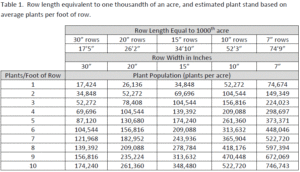The June 6 Tennessee crop progress report indicated over seventy percent (72%) of our soybean crop was in the ground, which is an improvement over the past few years. However, wheat dry down and double crop planting are on hold as daily rain is forecasted in many counties. Constant wet weather and warm temperatures create not only planting delays, but also issues with seed and seedling rots in fields planted within the past week, especially where no fungicide seed treatment was applied. It will be important to continue to monitor stand quality to identify any problem areas.
About 8 percent of our soybean crop was planted in April, surpassing previous years’ acreage. Depending on the maturity, indeterminate April planted soybeans will bloom about 45 to 50 days from planting and will begin to set pods about 63 to 70 days from planting. That means our early April planted soybeans are blooming and heading towards early pod. For growers that are new to April soybeans, it is important to keep an eye on growth stage and monitor progress, in order to time an R3-R4 fungicide correctly. Also, keep in mind that April planted beans can be more attractive to insects because they are setting pods and seed earlier, so scout periodically after bloom, and apply an insecticide if needed to above-threshold insects.
June Planting Considerations: As we transition into June, the goal should be to capture sunlight and close the canopy quickly in order to suppress weeds and conserve moisture, which may be helpful to dryland beans in July and August. We can do this by planting on narrow rows and by not skimping on seeding rates. UT and other university research has not shown yield differences when planting on 7.5”, 15” or 20” rows. A row spacing of < 20” is considered ‘narrow’ and superior to 30-38 inch rows with respect to June plantings. It is important to not under plant June beans (dropping <140,000 seeds/ac), as the goal is to create more leaves to capture sunlight quickly and lap row middles. Narrow row planters and newer drills that singulate and control depth more effectively allow minimum planting rates of 140-150,000 seeds/ac in double crop fields. Always evaluate double crop field conditions and increase seeding rates if in doubt; especially in tough residue or hard ground where seed coverage is poor, or where seed loss is expected to be greater. If using older drills that ‘control spill’ seed, seeding rates should be adjusted upwards by 15 to 20%. It is a good idea to shallow up the planter ahead of several days of rain as long as seed are covered well, but if planting ahead of dry weather, set the equipment deep enough (1.25 to 1.5 inches) to get good seed coverage and more uniform emergence.
Recent planting date studies have demonstrated that the most consistent maturity group for planting now is a maturity group 4 or 5 (our work included mid to late MG 4 and early MG 5 varieties). If irrigation is an option, late MG 3 varieties allow for earlier harvest and can be more stable than a MG 5 variety, but have never performed as well as a fuller season bean under dryland conditions when planted in June. If planting is delayed into late July, consider backing up to an earlier MG (early MG 4 preferred or late MG 3) to have the best chance at maturing a crop before a freeze. Tall varieties with good standability can work as a June planted soybean, as beans will shorten up with the compressed season.
Since June has been a wet month for most counties, consider adding at least a fungicide seed treatment to all seed planted now. Warm temperatures and moisture increase likelihood of seed and seedling rots in low lying and poorly drained areas of the field. A fungicide may improve stand and mean the difference between a stand that is good enough to keep versus a replant. Insecticide seed treatments (IST) are not always needed for June planted beans, since soybeans emerge and grow off quickly. I have seen a few instances where an IST had real value in a June planting- one particular situation was improved control of three cornered alfalfa hopper that would have done considerable damage to the field. Often insecticide and fungicide are a package deal and there is not significant additional expense for added insect control.
Replanting Considerations: Since we are heading into mid-June, consider keeping a low but uniform soybean stand where ‘low’ is 70 to 80 thousand plants per acre (Table 1). Replant where stands are very poor or spot plant to fill in bare areas. Timely weed control will be important in fields with thinner stands that tend to canopy late. Where only spot replanting is needed, do it early while the existing crop is small. That second planting will catch up much quicker if the original stand is not more than one or maybe two trifoliates along. Use the same variety to spot replant, or if that isn’t possible then choose a similar maturity bean for a more uniform crop later in the season.


